MXA RACE TEST: THE REAL 2020 450 FOUR-STROKE SHOOTOUT
MXA RACE TEST: THE REAL 2020 450 FOUR-STROKE SHOOTOUT
Make no mistake about it, MXA isn’t looking at these six bikes for their play riding, enduro, offroad or professional practice riding prowess. To us, these are pure-bred race bikes, and that’s how we tested and rated them. Our information is just a suggestion. If you don’t like our test, you can find lots of internet shootouts with different results—perhaps one of those will jibe with your delicate sensibilities. But, be forewarned, we are the only ones who have raced all six bikes every week, dyno’ed all six bikes (on the same day, on the same dyno), weighed all six bikes, broken things on all six bikes and spent five months doing our shootout (instead of the one or two days of most shootouts). We used 10 different test riders of varying abilities and politeness who also raced all six bikes in classes from Novice to Vet to Pro.
HONDA CRF450 VS. YAMAHA YZ450F VS. KAWASAKI KX450 VS. KTM 450SXF VS. HUSQVARNA FC450
VS. SUZUKI RM-Z450 VS. MXA
We don’t care what some stranger on Facebook thinks of “MXA’s 2020 450 Shootout,” but we do care what serious motocross racers think, because they push the bikes they own to the edge of the envelope. That is our true audience, because that is also us. Lots of people read shootouts because they already bought a bike and are looking for verification that their $9000 investment was a good deal. Sorry, that’s the job of the guy who sold you the bike. Paradoxically, a lot of people also read shootouts because they like to read bad things about the bikes they would never buy. These readers neither own nor plan to buy any brand of 2020 motocross bike. They are looky-loos. Boiled down to its essence, the “2020 MXA 450 Shootout” is for serious racers who want to investigate every bike out there before they plunk down a big chunk of their nest egg.
2020 450 CONTENDERS
HONDA CRF450
WHAT DID HONDA CHANGE FOR 2020? The differences between a 2019 CRF450 and the 2020 model are limited to the Honda engineers lowering the battery 28mm down in the airbox, re-valving the Showa forks, changing the rear brake pad material, eliminating the rear rotor guard, and adding traction control (to go along with three maps and three launch control settings).
WHY SHOULD THE CRF450 WIN THIS SHOOTOUT? This is far and away the most exciting and powerful engine of 2020. It pumps out 59.74 horsepower at 9600 rpm. Best of all, the power is spread out more effectively throughout the powerband for 2020, reducing some of the violent acceleration from the 2019 CRF450’s 60.21 horsepower. The layout of the seat, bars, pegs and width are class-leading (however, the shift lever is very short).
WHY SHOULD THE CRF450 LOSE THIS SHOOTOUT? For all of its horsepower, the CRF450 is a twitchy, unpredictable and often scary machine to ride fast. Thanks to its complicated electronics suite, it can be toned down—but then it isn’t as fast. Finding the proper fore/aft balance on the CRF450 is a hit-or-miss affair. Any change to the front end affects the rear end negatively and vice versa. Additionally, the forks are too soft. The radiator overheats. The clutch is stone age. The chassis is rigid and, at 238 pounds without gas, it is 15 pounds heavier than the lightest bike in the class.
WHAT IS THE CRF450’S RETAIL PRICE? $9399.
HUSQVARNA FC450
WHAT DID HUSKY CHANGE FOR 2020? The differences between the 2019 FC450 and 2020 FC450 were limited to four major changes. First, Husqvarna broke away from KTM on suspension setup by softening the fork’s compression shim stack, eliminating free bleed in the mid-valve, raising the oil height by 20cc and upping the recommended air pressure from 152 psi to 155 psi. The shock spring rate was changed from 45 N/mm to 42 N/mm. Second, new mapping helped throttle response, and the vented airbox cover, one tooth more on the rear sprocket, and five mechanical changes to the top end gave the FC450 respectable horsepower and the most torque (36.37 pound-foot).
WHY SHOULD THE FC450 WIN THIS SHOOTOUT? Every MXA test rider loved the 2020 Husqvarna powerband. It was incredibly easy to ride when combined with the plusher suspension and perfect geometry. It produced more power and torque than the 2019 model. Most important, Husqvarna’s decision to set-up the suspension for its target audience produced a noticeable improvement in overall feel. It also has brilliant brakes, a hydraulic clutch, Pankl-built transmission and a 224-pound weight that makes it the second-lightest bike in the class.
WHY SHOULD THE FC450 LOSE THIS SHOOTOUT? The 2020 FC450 is not suited for Pro-speed riders, either in suspension setup or throttle response. The power builds slower than with any other model because the FC450’s airbox doesn’t breathe well enough—vents or not—and because the muffler has a restrictor in it. Fast riders want stiffer suspension and a harder hit.
WHAT IS THE FC450’S RETAIL PRICE? $10,099.
KAWASAKI KX450
WHAT DID KAWASAKI CHANGE FOR 2020? Nothing save for the gas tank graphics.
WHY SHOULD THE KX450 WIN THIS SHOOTOUT? The 2020 KX450’s power delivery is so brisk, clean and quick revving that it can easily hold its own, even though it is not very powerful. Ranking near the bottom in horsepower at every rpm on the curve, the KX450 puts its available power into the ground with a very lively feel. The chassis is stable in a straight line, has a light feel at turn-in and has a very modern vibe to it. It is also the lightest Japanese-made 450 at 233 pounds (5 pounds lighter than the Yamaha YZ450F and Honda CRF450, but 10 pounds heavier than the KTM 450SXF).
WHY SHOULD THE KX450 LOSE THIS SHOOTOUT? Even though most MXA test riders liked the agile frame for its tidy manners and eminently usable powerband, it had some disappointing issues. Even with hydraulic actuation, the clutch was weak (we removed the judder spring). The rear brake pedal had very little downward adjustment. The engine overheated in long motos (we switched to a 2.0 radiator cap). The jumbo-sized 250mm rear rotor was touchy. The plastic was very brittle (the fork guards break from roost). The airbox cover requires two different size wrenches and the nut-plate behind the airbox/seat bolt falls out of the fender. The rear suspension is too stiff for the front forks, and the Showa coil spring forks were unbelievably soft.
WHAT IS THE KX450’S RETAIL PRICE? $9299.
KTM 450SXF
WHAT DID KTM CHANGE FOR 2020? For 2020, the KTM 450SXF got new maps that offer a bigger difference between the mellow map and aggressive map, plus the aggressive map (map 2) has snappier throttle response. The 2020 KTM 450SXF has a larger 49-tooth rear sprocket. KTM supplies two airbox covers (vented and unvented). The 2020 engine gets a bronze top-end rod bearing and lighter rocker arms, and the piston has hard-anodized ring grooves, new camming and a box-shaped reinforcement under the piston’s dome. The forks have a new mid-speed valve, shim stack and free bleed.
WHY SHOULD THE 450SXF WIN THIS SHOOTOUT? The 2020 KTM 450SXF has the broadest range of power, with the most horsepower in the midrange (6500 rpm to 9300 rpm) of all the 450s in this shootout. It also has the strongest brakes and comes with a Belleville-spring, hydraulically activated clutch (with a CNC-machined steel basket). KTM’s chromoly steel frame delivers the best all-around handling and isn’t as stiff and rigid as the Big Four’s aluminum frames. Changing the air filter requires no tools. It offers the best shifting in the class, even under a load. It comes with an optional quick-turn throttle cam. The electronics include two maps, traction control and launch control. And, at 223 pounds, it is the lightest 450 of 2020 by as much as 18 pounds.
WHY SHOULD THE 450SXF LOSE THIS SHOOTOUT? The WP XACT air forks are controversial. Some riders like their adjustability and the 3-pound weight savings, while others prefer 3-pound heavier coil-spring forks for their plusher feel. The most common complaint is the 450SXF engine isn’t snappy or quick revving. While it does rev slower, it makes the most horsepower and torque in the meat of its powerband and is no slouch at peak.
WHAT IS THE 450SXF’S RETAIL PRICE? $9999.
SUZUKI RM-Z450
WHAT DID SUZUKI CHANGE FOR 2020? We’d like to say that they changed the radiator wing graphics, but actually they just changed the color of one panel of the tank graphics. There were no technical updates.
WHY SHOULD THE RM-Z450 WIN THIS SHOOTOUT? The MXA test riders liked the pleasant midrange powerband of the RM-Z450. It makes 54.39 horsepower at its 8800 rpm peak. That is the least peak horsepower of any of the six 2020 450s, but it is only 1-1/2 horses less than the 2020 KX450 and the same torque number as the YZ450F. But, that is just sugar on horseradish. In truth, the 2020 Suzuki has issues. It was all-new in 2018, but the 2018 changes weren’t a positive step for the RM-Z450. Instead of a new frame and suspension, MXA wishes that Suzuki had kept the old frame and suspension and put a new engine in it.
WHY SHOULD THE RM-Z450 LOSE THIS SHOOTOUT? The chassis is out of balance. The stinkbug layout transfers too much weight to the front wheel, which creates oversteer. Oversteer wasn’t a problem on the old frame, but the new aluminum frame is too stiff, too tall and too steep. The Showa forks are the same units as on the CRF450 and KX450, but Suzuki’s choice of valving is better than the red or green choices. Unfortunately, the forks are ruined by the road-race-inspired Showa BFRC rear shock. It moves too freely, too quickly and can’t stay in contact with the ground in choppy transition corners. Sadly, all Suzuki had to do was spec the non-BFRC RM-Z250 shock on the 450 chassis, because the RM-Z250 shock is so over-sprung that it would work better on the RM-Z450. Did we mention that the 2020 RM-Z450 weighs 241 pounds (without gas)?
WHAT IS THE RM-Z450’S RETAIL PRICE? $8999.
YAMAHA YZ450F
WHAT DID YAMAHA CHANGE FOR 2020? The cylinder head is lower and narrower. The cams have been moved 14mm closer to each other. The valves are angled 7 degrees more upright, and the compression ratio has been upped. Yamaha’s engineers long-rodded the YZ450F and increased the diameter of the head pipe by 3.2mm. Although the frame geometry is unchanged, the thickness of the inner side of the frame spars is made thinner, while the frame cradle’s tubing has been increased in thickness on its top and bottom exposures. There is a more rigid front brake caliper, along with an upsized 25.4mm piston (from 22.65mm). The front brake pads are 29.2 percent larger, and the rear rotor has been reduced in size from 245mm to 240mm.
WHY SHOULD THE YZ450F WIN THIS SHOOTOUT? This is the best Yamaha YZ450F to come down the pike in a decade. It is perky off the bottom and goes a little soft in the low-to-mid transition (making 3 horses less than the KTM 450SXF) but then makes a strong transition into a romping top-end pull. With the trustworthy Kayaba SSS forks and shock helping out, the MXA test riders liked the handling of the new chassis. It was much improved at corner entrance, when leaned over in a rut, and when front-tire accuracy was of the utmost importance. We think the engine’s soft bottom, expanding midrange and ultra-strong top end are why the YZ450F handled so much better (because there are no geometry changes from 2019 to 2020). Except for a little burp off-idle, this is a smooth 58.56-horsepower engine that peaks at a very high 9700 rpm.
WHY SHOULD THE YZ450F LOSE THIS SHOOTOUT? A lot of its charms (power and suspension) are ruined by its traditional oddness. If you didn’t like the Yamaha YZ450F in the past because it was big, bulky, wide, tall, loud and heavy, it still is.
WHAT IS THE YZ450F’S RETAIL PRICE? $9399.
EIGHT UNDENIABLE 2020 MXA SHOOTOUT FACTS
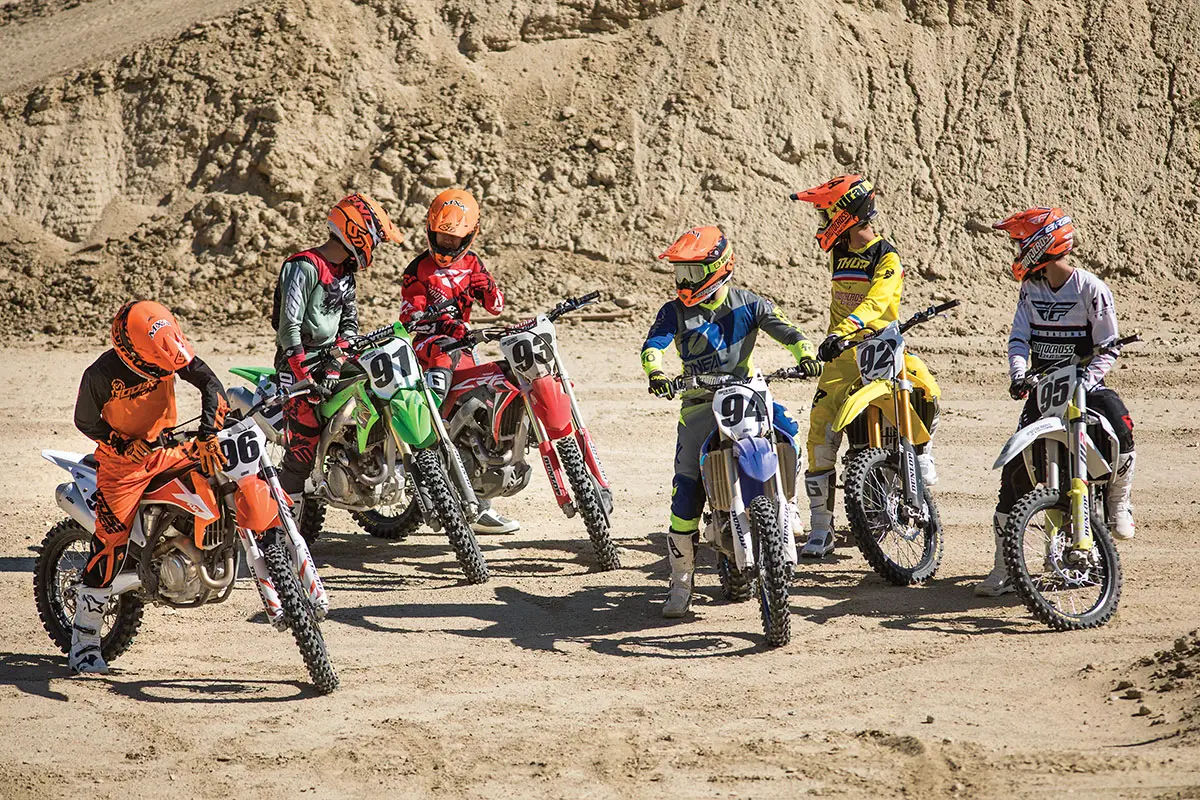 Motorcycle shootouts are funny things. They bring out attributes, both good and bad, that you would never discover by riding any individual bike by itself. They also tell us something about motocross racers’ tastes and the manufacturers’ willingness to address their customers’ wants and needs. Here are eight undeniable facts about shootouts.
Motorcycle shootouts are funny things. They bring out attributes, both good and bad, that you would never discover by riding any individual bike by itself. They also tell us something about motocross racers’ tastes and the manufacturers’ willingness to address their customers’ wants and needs. Here are eight undeniable facts about shootouts.
(1) THE MYTH OF POWER
Neither the fastest bike (CRF450) nor the slowest bike (RM-Z450) won MXA’s 2020 450 Shootout. Why not? Motocross is more about power quality than power quantity. It’s not how much you make, it’s how you make it; however, if you don’t make enough power, it doesn’t matter how you make it.
(2) THE CORNERING FABLE
The sharpest-turning bikes in this shootout, the RM-Z450 and CRF450, are one-trick ponies. They turn very well, but they shake at speed, twitch in the rough and require a St. Christopher medal on big, fast tracks. Overall handling prowess does not come with the best cornering pedigree—Supercross handling does, though.
(3) THE AIR FORK CONUNDRUM
WP’s air forks have been painted negatively by the failed Showa and Kayaba air forks. The SFF-TAC and PSF forks tainted the marketplace. The XACT air forks on the Husky and KTM are victims of three things: (1) Showa’s SFF-TAC and Kayaba’s PSF air forks’ dismal performance turned racers against air forks. (2) Air forks require riders, who rarely check the air in their tires, to actually adjust the WP XACT’s air pressure. (3) WP set-up specs, including the sticker on the fork, recommend air pressures that only work for fast riders. Most in-the-know XACT fork users run much lower air pressures, often as much as 20 psi lower.
(4) THE FOUR-YEAR RULE
As a rule, motorcycle manufacturers are working so far in the future that they seem unresponsive to consumer complaints. For example, the 2020 CRF450 shift lever is too short. It is hard to get your boot under it. The fork spring rates on the 2020 KX450 and CRF450 are too soft, while the KX250 and RM-Z250 fork springs are too stiff. Will they fix these flaws in 2021?
(5) THE CLUTCH CONUNDRUM
Every Japanese manufacturer selects its clutch spring rates based on how easy they can make the clutch pull feel on the showroom floor. The downside is that the Kawasaki, Suzuki, Honda and, to a lesser extent, Yamaha clutches aren’t up to the task at hand for heavy clutch users. A new clutch costs $90 for fiber plates alone, so enjoy that showroom moment as much as possible, because you’ll be back with your credit card next month. The KTM and Husqvarna clutches will likely last at least three times longer than any Japanese clutch.
(6) THE SEAT HEIGHT DILEMMA
The MXA test riders come in all shapes, sizes and speeds, but modern motocross bikes come in only one size—extra large. There are no bikes suited to riders under 5-foot-8. Short riders’ feet dangle on the starting line. Motocross bikes don’t have to be this tall. Many factory riders run cut-down subframes, longer shock linkages and lower seats to get the fit they need. Until the Big Six realize the error of their ways, short riders will have to go tippy-toe.
(7) THE BARGAIN THAT ISN’T A BARGAIN
The price difference between the least and most expensive 2020 450 motocross bikes is $1100. Many buyers think that they could buy the cheapest 450 motocross bike, the $8999 Suzuki RM-Z450, and add an aftermarket exhaust system, port the head, have the suspension re-valved and turn their bargain into a gem. Sadly, that strategy adds $2000 to the price tag, which would make your bargain 2020 RM-Z450 cost a real-world $10,999.
(8) THE BEST BIKE MYSTERY
In reality, there is no “best bike” in MXA’s six-bike shootout. Instead, there are six bikes that aren’t well suited to every rider’s personality, riding style or speed. The worst bike in this shootout could well be the best bike for you. The fastest bike could be the worst. And the plastic color that matches your gear just might be the lamest reason to buy a brand.

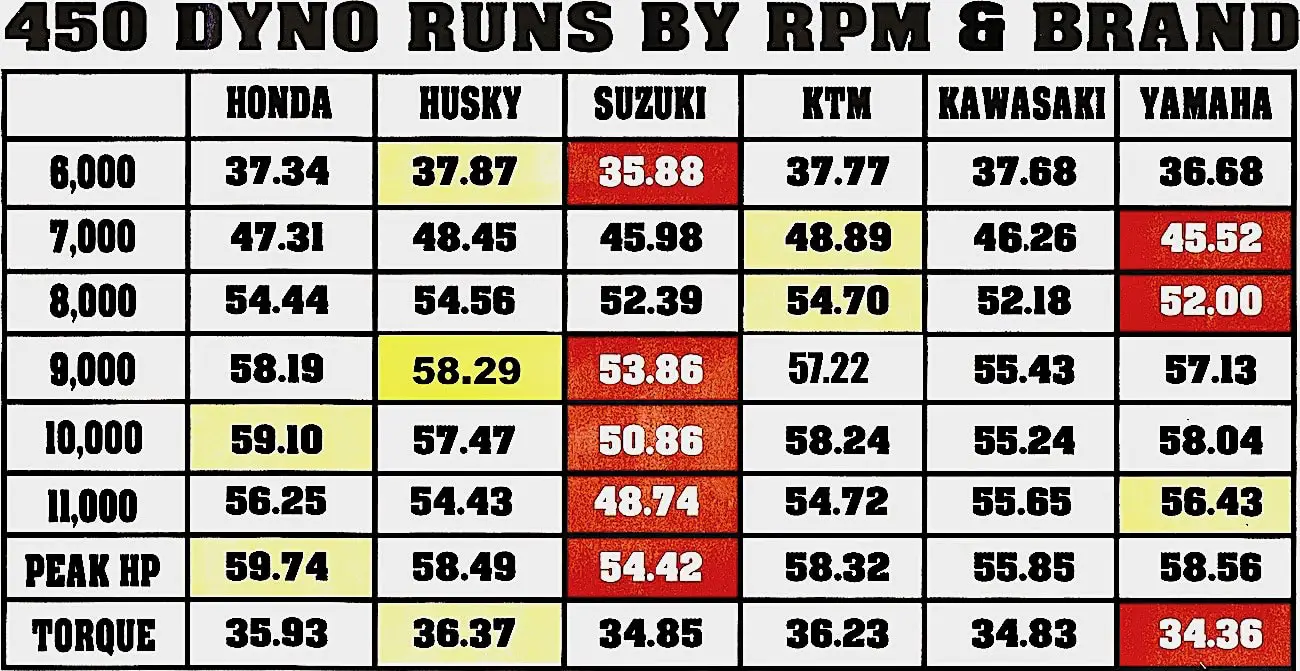 Yellow boxes indicate the best performance at that rpm, red boxes are the worst.
Yellow boxes indicate the best performance at that rpm, red boxes are the worst.
WHAT THE 2020 450s ACTUALLY WEIGH
Have you every wondered why the AMA and FIM instituted minimum weight rules? Minimum weights were imposed for reasons of safety and equality. Since lighter bikes work more efficiently, the sanctioning bodies were afraid that a manufacturer would cut corners to build the lightest possible bike, forcing other teams to build even lighter bikes. Before weight limits were legislated, there were lots of high-profile failures with the 180-pound works bikes of the era. Weight limits set an acceptable standard for safety and to keep privateers competitive against factory teams. The current minimum weight limit for a 450cc motocross bike is 220 pounds.
These are the actual weights of the current crop of 2020 motocross bikes (lightest to heaviest). They have been weighed on the same calibrated balance-beam scale under the official AMA and FIM system of empty gas tanks but all other fluids.
2020 450 MOTOCROSS BIKE WEIGHTS
1. KTM 450SXF…223
2. Husqvarna FC450…224
3. Kawasaki KX450F…233
4. Yamaha YZ450F…238
5. Honda CRF450…238
6. Suzuki RM-Z450…241
WHAT THE 2020 450s ACTUALLY COST
These are the manufacturers’ suggested retail prices (MSRP) for all six 2020 450s. Of course, the dealer is free to lower the price if he is over-stocked, and by the same token, a dealer can raise the price if the bikes on his showroom floor are in limited supply. Thus, the MSRP is little more than a guide.
It is important to remember that bike prices are set in the country of origin. That means that the price in the USA is determined by the exchange rate of the euro to the dollar for KTM and Husky and the yen for Honda, Yamaha, Suzuki and Kawasaki.
2020 450 MOTOCROSS BIKES MSRP
Suzuki RM-Z450…$8999
Kawasaki KX450…$9299
Honda CRF450…$9399
Yamaha YZ450F…$9399
KTM 450SXF…$9999
Husqvarna FC450…$10,099
MXA’S RECOMMENDED 2020 SUSPENSION SETTINGS
During MXA’s shootout period, which lasted from June 2019 to today, we tried virtually every setting imaginable on riders of all skill levels. Suffice it to say that the Pros wanted the suspension stiffer and the Vets wanted it softer. The settings below are good starting points for most riders but will probably not work for a 130-pound rider or an aspiring Supercross star. The stock suspension settings are in parentheses. Click to your heart’s content.
2020 HONDA CRF450 FORK SETTINGS
Spring rate: 5.0 N/mm
Compression: 6 clicks out (Pro), 12 clicks out (Intermediates), 13 clicks out (Vets), (12 clicks out)
Rebound: 10 clicks out (12 clicks out)
Fork-leg height: Flush with stock fork (until you re-valve them)
Notes: Pro test riders ran the compression on 6 clicks out and the rebound on 9 clicks out. Intermediates ran both the compression and rebound on 12 clicks out. Vet and Novice test riders went with 13 clicks out on both clickers. We had issues with a very harsh feel in small braking bumps and an overly soft feel on bigger bumps and jump landings. We could not iron it out with the clicks available to us.
2020 HONDA CRF450 SHOCK SETTINGS:
Spring rate: 56 N/mm
Hi-compression: 2-3/4 turns out (3 turns out)
Lo-compression: 10 clicks out (9 clicks out)
Rebound: 7 clicks out (9 clicks out)
Race sag: 107mm
Notes: We set the race sag at 107mm to lower the overall bike height while using fork-leg height to balance out the frame geometry. We ran a longer shock link to lower the rear end and stiffen the compression damping at the initial startup point. If you are light, switch back to 2017’s 5.4 N/mm spring, but try softening all the clickers on the 2020 shock by four clicks first.
HUSQVARNA FC450 FORKSETTINGS
Spring rate: 145 psi (155 psi)
Compression: 15 clicks out (12 clicks out stock)
Rebound: 10 clicks out (12 clicks out stock)
Fork-leg height: Third line
Notes: The recommended air pressure is 155 psi (10.7 bar). Most riders chose much softer air pressures. The Husqvarna forks have both a higher oil height and higher recommended air pressure than their KTM brethren. Why? Because the softer damping needed help in both bottoming control (oil height) and ride height in the stroke (air pressure). Pay attention to extreme temperature changes. It doesn’t hurt to reset the air pressure to your chosen settings between motos (once the forks have cooled down from riding).
2020 HUSQVARNA FC450 SHOCK SETTINGS
Spring rate: 42 N/mm (45 N/mm for over 185 pounds; 48 N/mm for over 210 pounds)
Hi-compression: 1-1/4 turns out (1-1/2 turns out stock)
Lo-compression: 15 clicks out
Rebound: 10 clicks out (15 clicks out stock)
Race sag: 105mm
Notes: We turned the high-speed compression damping in a 1/4 turn to lessen G-outs and ran more rebound than the recommended setting. Additionally, some test riders ran the race sag at 107mm and slid their forks up 2mm to get the bike down in the corners.
2020 KAWASAKI KX450 FORK SETTINGS
Spring rate: 5.1 N/mm (5.0 N/mm for light riders, 5.1 N/mm for Vet riders, 5.2N/mmm for fast riders)
Compression: 14 clicks out
Rebound: 12 clicks out
Fork-leg height: 2mm up (0mm)
Notes: The stock fork spring rate is 5.0 N/mm. That is too soft for anyone going race speed; however, Kawasaki’s optional 5.2 N/mm fork springs were too stiff for anyone but pros. Our solution was to run non-existent 5.1 N/mm fork springs. Since no such spring was available, we made our 5.1 N/mm fork spring rate by running a 5.2 N/mm spring in one leg and a 5.0 N/mm spring in the other leg. When we rode with the stock 5.0 N/mm fork springs, we slid the forks down in the clamps to hold the front of the bike higher.
2020 KAWASAKI KX450 SHOCK SETTINGS
Spring rate: 54 N/mm
Hi-compression: 1-1/4 turns out
Lo-compression: 18 clicks out
Rebound: 12 clicks out
Race sag: 105mm
Notes: The shock was easy as pie to set up. The rear end had minimal wallowing and worked very well under braking in chop and square-edged bumps. Light riders under 150 pounds might want to switch to the optional 52 N/mm shock spring.
2020 KTM 450SXF FORK SETTINGS
Spring rate: 140 psi (Novice), 145 (Intermediate), 152 psi (Expert)
Compression: 20 clicks out (12 clicks out)
Rebound: 15 clicks out (18 clicks out)
Fork-leg height: Third line
Notes: The recommended air pressure is 152 psi, while the stock compression set is at 12 clicks out and the rebound at 18 clicks out. Most test riders chose air pressure that was lower than the recommended 152 psi (10.5 bar). Once we found the correct air pressure (via the zip-tie method), we used the compression damping to fine-tune the travel.
2020 KTM 450SXF SHOCK SETTINGS
Spring rate: 45 N/mm
Hi-compression: 1-1/2 turns out (2 turns out)
Lo-compression: 15 clicks out
Rebound: 10 clicks out (15 clicks out)
Race sag: 105mm
Notes: We set the race sag at 105mm (but some riders went as far as 108mm). KTM’s rear shocks are very spring-rate sensitive. The window of the available 42 N/mm, 45 N/mm and 48 N/mm shock springs is very small. The target rider weight of the stock 45 N/mm shock spring is 175 pounds. It works well for riders from 160 to 185 pounds, but static sag (free sag) must be between 30mm and 40mm (unladened).
2020 SUZUKI RM-Z450 FORK SETTINGS
Spring rate: 0.50 N/mm
Compression: 10 clicks out (6 clicks out)
Rebound: 12 clicks out
Fork-leg height: Adjust it for the handling, not the suspension
Notes: For faster riders or on tracks with big jumps, we added 10cc of oil to both fork legs to stiffen the forks in the last 4 inches of travel to stop them from bottoming. This gave us more leeway in dialing in the compression. MXA test riders ran the compression from seven to 12 clicks out, depending on rider speed and track conditions.
2020 SUZUKI RM-Z450 SHOCK SETTINGS
Spring rate: 54 N/mm
Hi-compression: N/A
Compression: 1 turn out (1-1/2 turns out)
Rebound: 1 turn out (3 turns out)
Race sag: 108mm (105mm)
Notes: We hated the high-in-the-rear layout of the 2020 RM-Z450. We ran a longer shock linkage to lower the rear of the bike and stiffen the initial shock damping. On the BFRC shock, the compression and rebound are adjusted by counting turns on the bleed screws, not by clicks. The BFRC shock does not have a high-speed compression adjuster. Additionally, there is no rebound adjuster under the shock. Both compression and rebound adjusters are mounted on the piggyback and labeled “Ten” for rebound and “Com” for compression.
2020 YAMAHA YZ450F FORK SETTINGS
Spring rate: 0.50 N/mm
Compression: 9 clicks out (8 clicks out)
Rebound: 8 clicks out (10 clicks out)
Fork-leg height: 5mm up
Notes: For 2020, Yamaha has refined what were already the best forks on the market. What’s best about them? They work for Beginners, Novices and AMA Pros. They don’t care if you’re thin or fat, tall or short. There’s a setting for everyone. Be very careful with the compression clicker. One clicker is the equivalent of a couple clicks on other brands of forks.
2020 YAMAHA YZ450F SHOCK SETTINGS
Spring rate: 58 N/mm
Hi-compression: 10 turns out
Lo-compression: 12 clicks out
Rebound: 11 clicks out
Race sag: 105mm (100mm stock)
Notes: We thought the 58 N/mm shock spring was going to be too stiff for slower and lighter riders, so we had 2017’s 56 N/mm spring with us just in case. Amazingly enough, we had riders as light as 150 pounds still get acceptable race sag from the stiff spring.
WHAT WE HATE ON THE 2020 450s
There is no such thing as a perfect bike. Even the best bikes have warts, while the worst bikes often shine in the occasional category. In this section, the MXA wrecking crew is going to list the things they hate.
HONDA CRF450
WHAT WE HATE
1. Clutch. Get rid of the judder spring and add a full-size friction plate. Plus Honda needs to do something with the clutch cam to get a wider engagement window.
2. Radiators. It boils water like a steam iron.
3. Exhaust. Honda’s twin mufflers are just wrong. heavy, but wrong. Expensive, but wrong.
4. Handling. Good on a turn track—scary on a fast outdoor track.
5. Weight. 238 pounds.
6. Setup. This is the most difficult bike to set up and dial in.
7. Forks. The forks are too soft.
8. Electronics. Some brand was bound to take mapping, traction control and launch control too far.
HUSQVARNA FC450
WHAT WE HATE
(1) Blue frame. It looks old and weathered on the showroom floor.
(2) Compression clicker. The three-prong fork compression clicker now has two-prongs. A push.
(4) Graphics. Graphics shouldn’t miss the bike.
(2) Vented airbox. We are not okey-dokey with fake vents.
(5) Airbox cover. Removing the airbox cover is a wrestling match.
KAWASAKI KX450F
WHAT WE HATE
(1) Rear brake pedal. The rear brake pedal needs more downward adjustment. The rear rotor is touchy.
(2) Airbox. So close to good and yet so far.
(3) Clutch. It’s hydraulic, but it’s not as good as the the KTM and Husky hydraulic clutches.
(4) Handlebars. The 7/8-inch handlebars are so cluttered with accessories that there is no room left.
(5) Bar mounts. The rubber in the rubber-mounted handlebar mounts has the consistency of Silly Putty.
(6) Levers. The clutch and brake levers are completely different‚ as though they came off different bikes.
(7) Fork guards. Kawasaki might as well make its fork guards out of glass.
(8) Shock preload ring. Why copy KTM’s horrible preload ring?
(9) First-year model. In 2019, the KX450 was a “First-Year Model.” We are surprised that they didn’t fix the obvious flaws for 2020.
KTM 450SXF
WHAT WE HATE
(1) Compression clicker. The three-prong compression clicker has been changed to a two-prong clicker. It didn’t help.
(2) Frame stiffness. Making the frame stiffer in 2019 worked for Pros, but Vets think it made the frame too rigid.
(3) Frame color. Nobody wants a black frame. KTM needs to paint it orange and leave it orange.
(4) Throttle cam. The stock gray throttle cam has an incredibly long throw. Luckily, KTM includes a black quick-turn throttle cam with each bike.
SUZUKI RM-Z450
WHAT WE HATE
(1) Clutch. This isn’t the worst clutch, but it’s only a hair better than the worst one.
(2) Weight. Invest in an electric bike stand or a gym membership, because you will need it.
(3) Brakes. Suzuki has the weakest front brake of those bikes with 270mm rotors.
(4) Handling. The first time the RM-Z450 head shakes down a 40-mph straight, you are going to become a shade-tree engineer.
(5) Kickstart. Not every bike needs an electric starter, but the Suzuki RM-Z450 does because it’s kickstart lever is very high on the cases and requires a full kick.
(6) BNG. The 2020 Suzuki RM-Z450 updates are limited to a blue stripe instead of a red one on the gas tank.
(7) Tire choice. The Bridgestone M30 rear tire weighs almost 2 pounds more than a Dunlop.
(8) Power. It doesn’t make much in the way of peak horsepower, but the power it makes is incredibly usable.
YAMAHA YZ450F
WHAT WE HATE
(1) Handlebar position. Yamaha lowered the handlebars 5mm (to where they were in 2017), but the OEM position is 16.5mm farther forward. The bar setup was awkward. We put the bar mounts back to where they were last year.
(2) Weight. This bike needs a massive weight loss program. Without fuel in the tank, it weighs 238 pounds. With fuel in the tank, it weighs 247 pounds.
(3) Exhaust pipe. When you put the cylinder head on backwards, the pipe has to go forwards before it can go backwards. It is a pain to remove. Sadly, Yamaha has no intention of turning the cylinder around, even though it is getting closer to being upright.
(4) Air filter. We think that this is the worst air filter on the track.
(5) Airbox cover. You remove it the same way you open a bag of Fritos—by tearing at it until it breaks free;. This could be so much better.
(6) Seat. You feel like you are sitting in a hole on the YZ450F—an unpadded hole, but Yamaha keeps adding denser foam each year.
WHAT IS THE THE BEST WEEKEND-WARRIOR 450
If racing is something you only do occasionally, preferring to ride your bike at local tracks and in the hills, you don’t need the fire-breather that most serious racers desire. Most weekend warriors keep their bikes much longer than hardcore racers, thus durability is a priority. These are the three best 450cc bikes for a weekend warrior to purchase.
(1) Yamaha YZ450F: MXA’s in-house slogan is, “We don’t make ’em, we just break ’em.” For our money, Yamaha builds an absolutely bulletproof product. We rarely break anything on a YZ450F, never adjust the valve train and content ourselves with changing tires to get our maintenance fix.
(2) Husqvarna FC450: Husqvarna is the first manufacturer to actually build suspension that is best suited to the average person instead of the Supercross hero. With its mellow powerband, accurate handling and plush suspension, the FC450 is the perfect bike for a guy looking for the perfect bike to ride, race or play on.
(3) Suzuki RM-Z450: Not only is the Suzuki RM-Z450 the least expensive bike in 2020, Suzuki dealers have been known to cut prices to bargain rates. One caveat: if you buy a 2020 RM-Z450 to ride on the weekends, don’t spend any money on aftermarket parts. Get the shock fixed and leave everything else alone. It’s a good bike for the price.
WHAT IS THE BEST VET-CLASS 450
Vet racers, made up of riders from 30 to 60 years old, are the power elite of modern motocross. They have the financial wherewithal to afford the bike of their teenage dreams. These are the three best 450cc four-strokes for veteran racers.
(1) KTM 450SXF: Thanks to its broad powerband, intuitive handling and light weight, the KTM 450SXF is the king of the Vet class. Plus, at 223 pounds, it is light enough for a guy with a lifetime of crash-related injuries to still be able to pick up.
(2) Husqvarna FC450: It delivers its power in an easily usable midrange manner. Husqvarna may not be willing to say it, but we will—Husky built the 2020 FC450 as a Vet-class dominator. It has real-world suspension settings (even if that world is “Leisure World”), an incredibly usable power delivery, and a high price tag that doesn’t scare a guy with a 401k.
(3) Kawasaki KX450: An all-around nice bike that only needs one stiffer fork spring to make it perfect for Vet racing. “Crisp” describes the power, handling and setup. It’s got some irritating flaws, but the fixes are not beyond the skill level of a guy who grew up before working on your own car, washing machine or dirt bike went out of fashion.
WHAT IS THE BEST PRO-CLASS 450
Pros are unique animals. They want everything for free. They have no intention of using any stock parts. They think they would be the Champ if they found the right bike. Not to mention that they will wear any brand of helmet, even ones made of paper mache, if they get paid. These are the three best 450cc bikes for an aspiring Pro.
(1) Honda CRF450: The 2020 Honda is the hardest-hitting, most hyper-active and highest-horsepower bike sold. It’s too much for the average racer. That definition makes every Pro want one. They don’t care about the stock suspension, handling or excess weight. They want to ride red.
(2) Yamaha YZ450F: Smart privateers know that they can race a YZ450F at every AMA Supercross and National without ever worrying about a failure. And now that the 2020 model is all new and high-rpm-fast, they want to race one.
(3) KTM 450SXF: Pros will ride whatever they can get for free, and the fact that no one wants to give them a KTM makes them want to ride it all the more. It is the bike with the strongest midrange, lightest weight and best overall handling. It is only a Pro’s choice if—and this is the big if—they can get some Cone Valves for cheap.
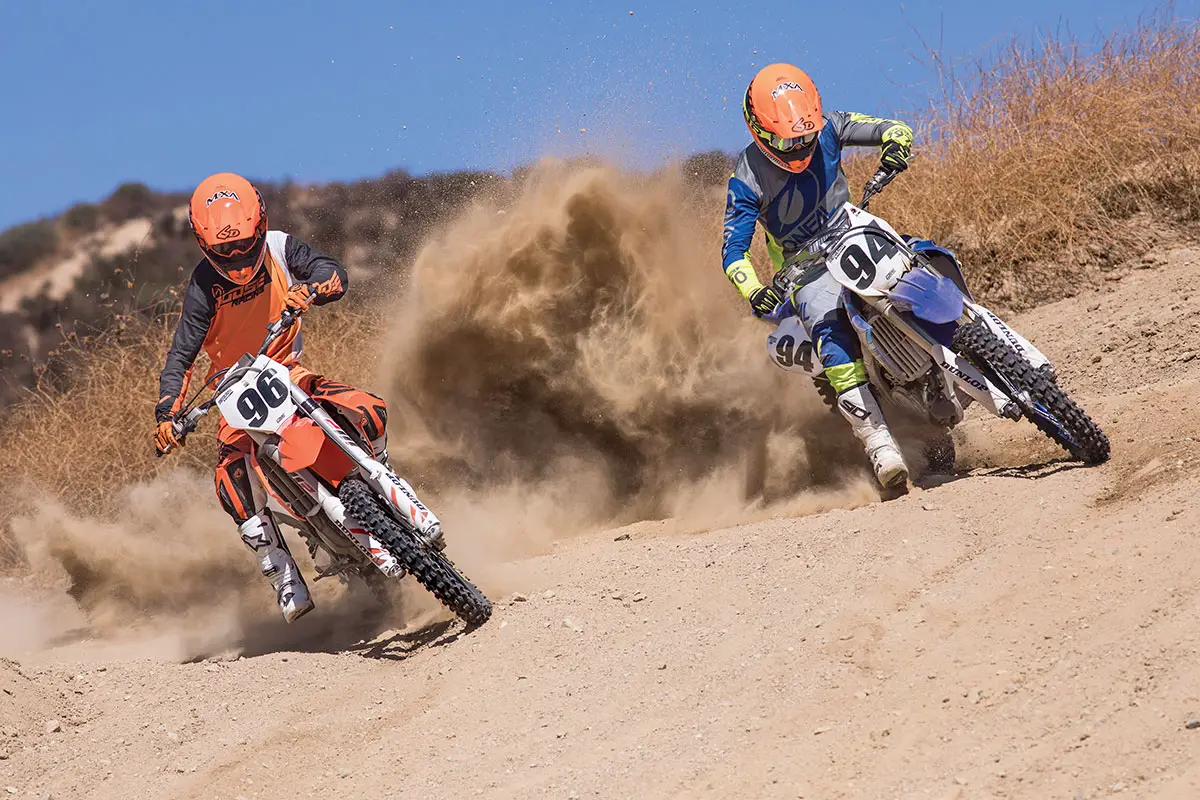
FINAL SHOWDOWN: 2020 YAMAHA YZ450F vs 2020 KTM 450SXF
After hundreds of laps, untold gallons of gas and late hours in the workshop, the MXA wrecking crew narrowed the potential winner of MXA’s 2020 450 Shootout down to two bikes—the KTM 450SXF and the Yamaha YZ450F. Only one of them could win, though, and that winner is about to be revealed.
Q: WHICH MAKES THE MOST HORSEPOWER, THE YAMAHA YZ450F OR THE KTM 450SXF?
A: They are very different but virtually equal in power. The KTM 450SXF has a more classic powerband—it makes 1.1 horsepower more than the YZ450F at 6000 rpm, 3.4 horses more at 7000 rpm, 2.7 horsepower over the YZ-F at 8000 rpm, and at 9000 rpm the KTM is 2 horses stronger than the YZ450F. But, the power profile isn’t a slam dunk for the KTM 450SXF because the YZ450F matches the KTM’s output at 10,000 rpm and, as the rpm climb, the YZ-F surpasses the KTM at 11,000 rpm to the tune of 1.7 horses more.
In the simplest terms, the KTM 450SXF is strong from low to high-mid, while the YZ450F is a mid-and-up engine. On the track, depending on how you prefer your power, they are comparable. The KTM 450SXF peaks at 8800 rpm (58.32 horses), while the YZ450F peaks at 9700 rpm (58.56 horses). On the orange bike, you ride in the meat of the midrange; on the blue bike, you rev it.
You don’t need Sherlock Holmes to tell you that the KTM is much stronger from idle through the midrange, while the YZ450F comes into its own on top. Neither engine is bad; they just work best in different brackets.

Q: WHICH ONE HAS THE MOST TORQUE, THE YAMAHA YZ450F OR THE KTM 450SXF?
A: The easy answer is the 2020 KTM 450SXF. It makes 36.23 pound-feet of torque at 7000 rpm. The 2020 Yamaha YZ450F makes the least torque of any 2020 450 at 34.36 pound-feet at 7400 rpm.
Q: WHICH ONE HAS THE BEST CLUTCH?
A: This is no contest. KTM’s diaphragm clutch is a thing of beauty. Not only is it super durable, it can withstand the most abusive test riders with nary a whimper. The Yamaha YZ450F has always had the best clutch of the Japanese-made Big Four, but it can’t come close to matching the longevity, actuation and positive feel of the KTM’s unique steel basket, Belleville washer-sprung, hydraulic clutch.
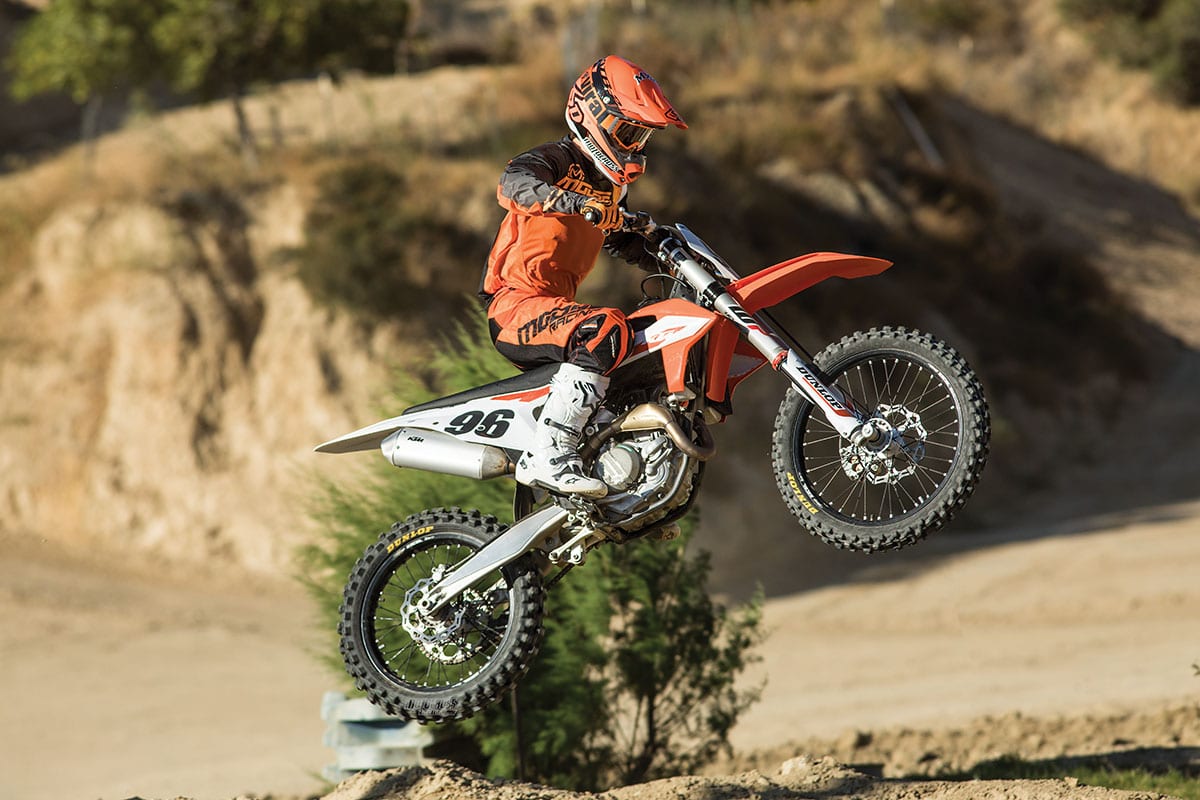
Q: WHICH ONE HAS THE BEST FORKS?
A: The Yamaha YZ450F’s Kayaba SSS forks have been the best forks since they were first introduced in 2006—and for the 14th year in a row they still take the top prize. KTM’s WP XACT air forks may have detractors, but given the setup issues of the KX450’s, CRF450’s, RM-Z450’s coil-spring-equipped 49mm Showa forks, the WP air forks can work for anyone who takes the time to set them up.
Q: WHICH ONE HAS THE BEST SHOCK?
A: There is nothing terrible about the WP rear shock on the KTM, but the Yamaha’s Kayaba shock is something special. Neither of these shocks’ clickers have been set very far away from the stock numbers.

Q: WHICH ONE HANDLES BETTER?
A: The KTM 450SXF’s handling is a dream. A racer could almost navigate the 450SXF around a race track with his eyes closed. It is so neutral that you don’t need any major input to get it to turn. Test riders claimed they could control it with their knees like a downhill skier. It is stable, agile and accurate. The YZ450F is no slouch, but when you hear the accolade that it is “the best-handling YZ450F ever,” that doesn’t mean it is the best all-around handling bike of 2020. It’s good but not great.
Q: WHICH ONE HAS THE BEST BRAKES?
A: We like that Yamaha has finally elected to fight back against the omnipotence of KTM’s Brembo brakes after a decade of benign neglect. But, Brembo isn’t that easy to knock off the pedestal. KTM’s brakes win this category thanks to incredible pucker power, excellent modulation and overall smoothness.
Q: HOW MUCH DO THEY WEIGH?
A: The KTM 450SXF hits the scales, without fuel in the tank, at 223 pounds. The Yamaha YZ450F weighs 238 pounds. There are moments on a racetrack where weight plays a negligible role, but where it matters most, like in acceleration, braking, yaw and fatigue (both metal and mental), weight really does matter.

Q: WHICH ONE HAS THE BEST ERGOS?
A: The KTM is sleek, slim and comfortable. Ergonomically, the Yamaha YZ450F wasn’t designed around the human body. The stock 2020 bar position must have been chosen for an orangutan. The seat feels like the rider is sitting in a hole. The gas tank splays the rider’s legs outward. The short Yamaha shift lever doesn’t work well with boots larger than size 10. And the YZ450F bombards the rider with blaring noise from both the pipe and the airbox at the same time.
Q: WHICH ONE DO WE THINK IS THE BEST ALL-AROUND 2020 RACE BIKE?
A: We race our test bikes every week. That means that we are looking for function over form and performance over flash. That said, the 2020 YZ450F and 2020 450SXF are the two best race bikes made. They aren’t flawless, but they are less flawed than the other offerings. We would love to call the 2020 MXA 450 Shootout a tie between the Yamaha YZ450F and KTM 450SXF, but that would be a cop-out. Man for man, every MXA test rider believed that the KTM 450SXF was the best all-around 450 motocross bike of 2020.
WHOA! WE’RE NOT DONE YET: FOR MORE DETAIL READ THE MXA TEST OF EACH 2020 450 BELOW
2020 KAWASAKI KX450 RACE TEST
2020 HONDA CRF450 RACE TEST
2020 KTM 450SXF RACE TEST
2020 HUSQVARNA FC450 RACE TEST
2020 YAMAHA YZ450F RACE TEST
2020 SUZUKI RM-Z450 RACE TEST


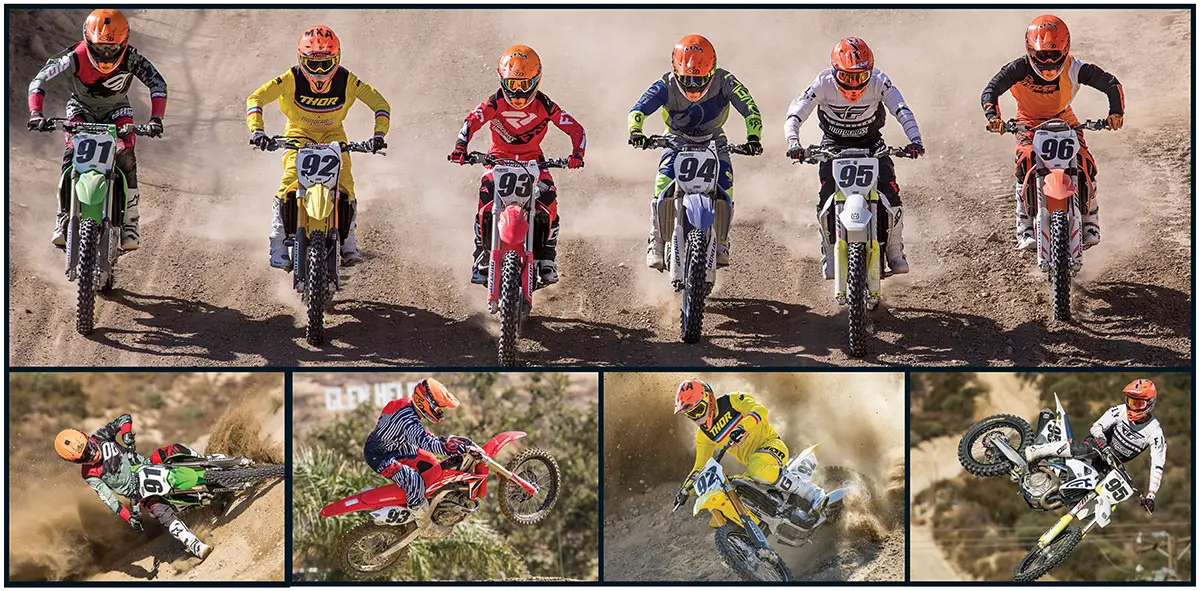
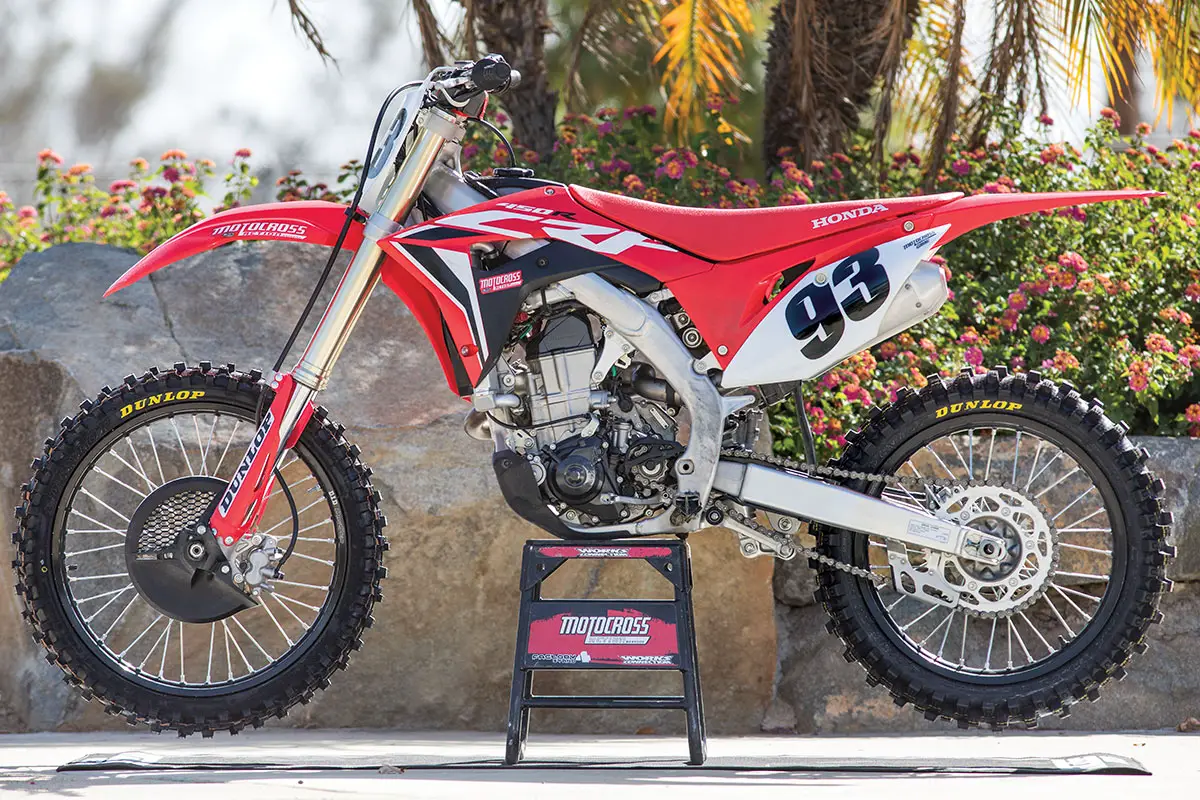

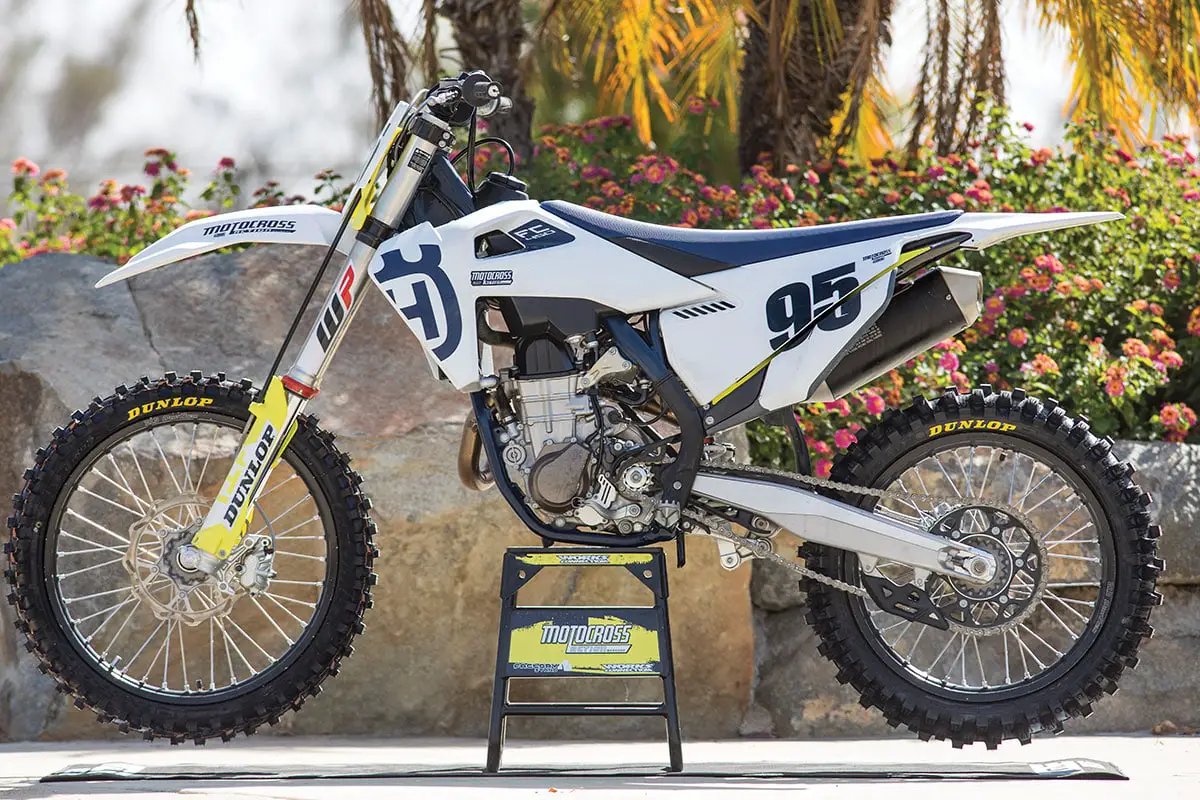
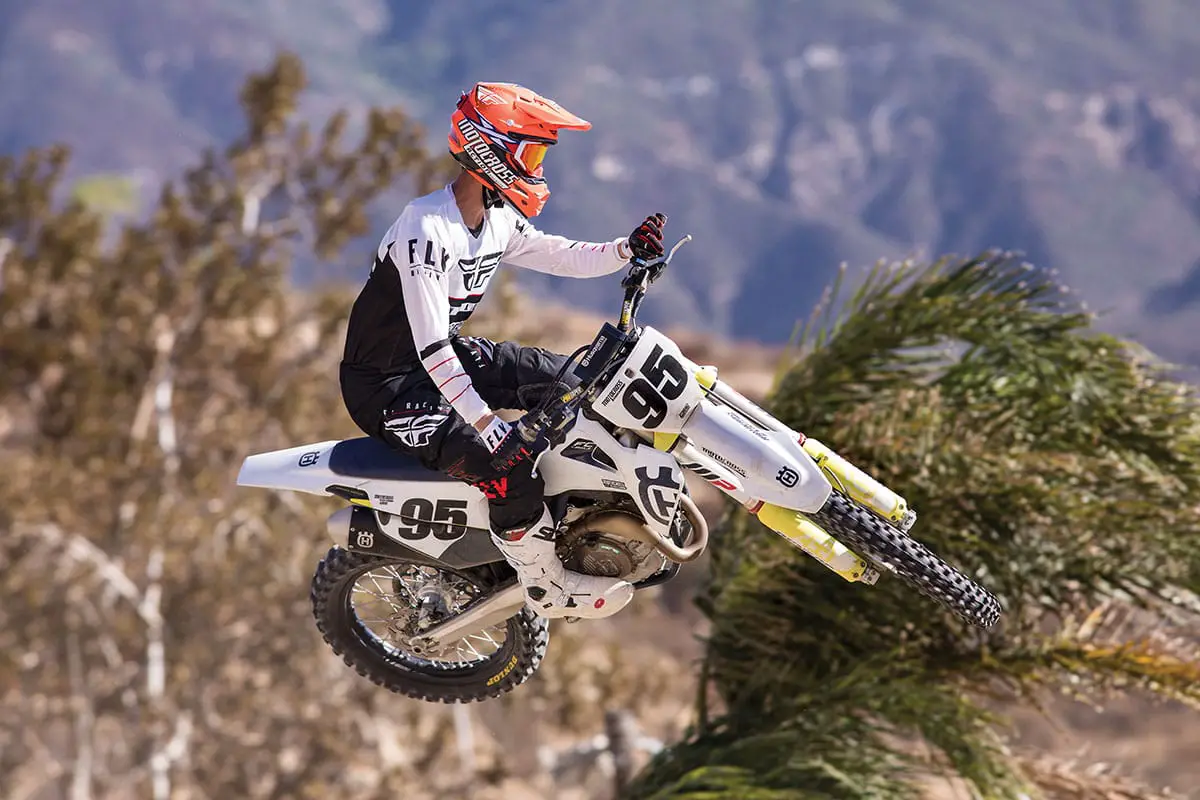

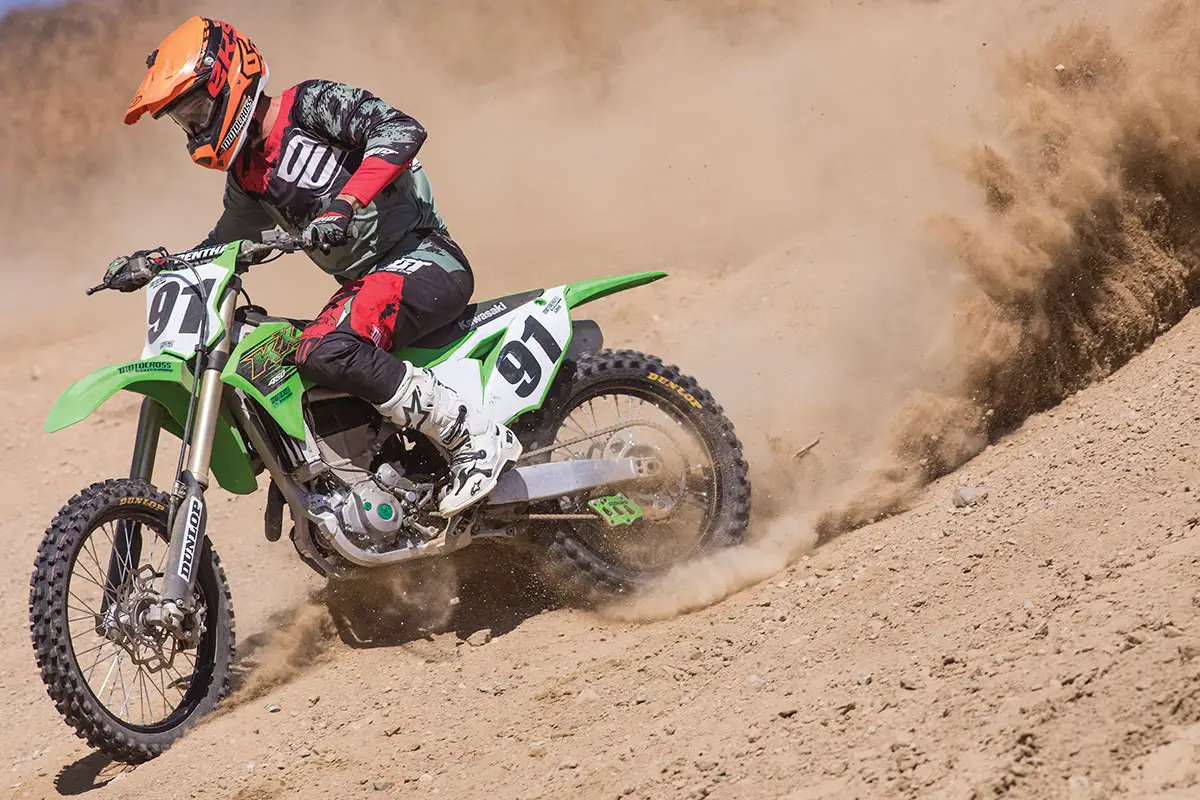
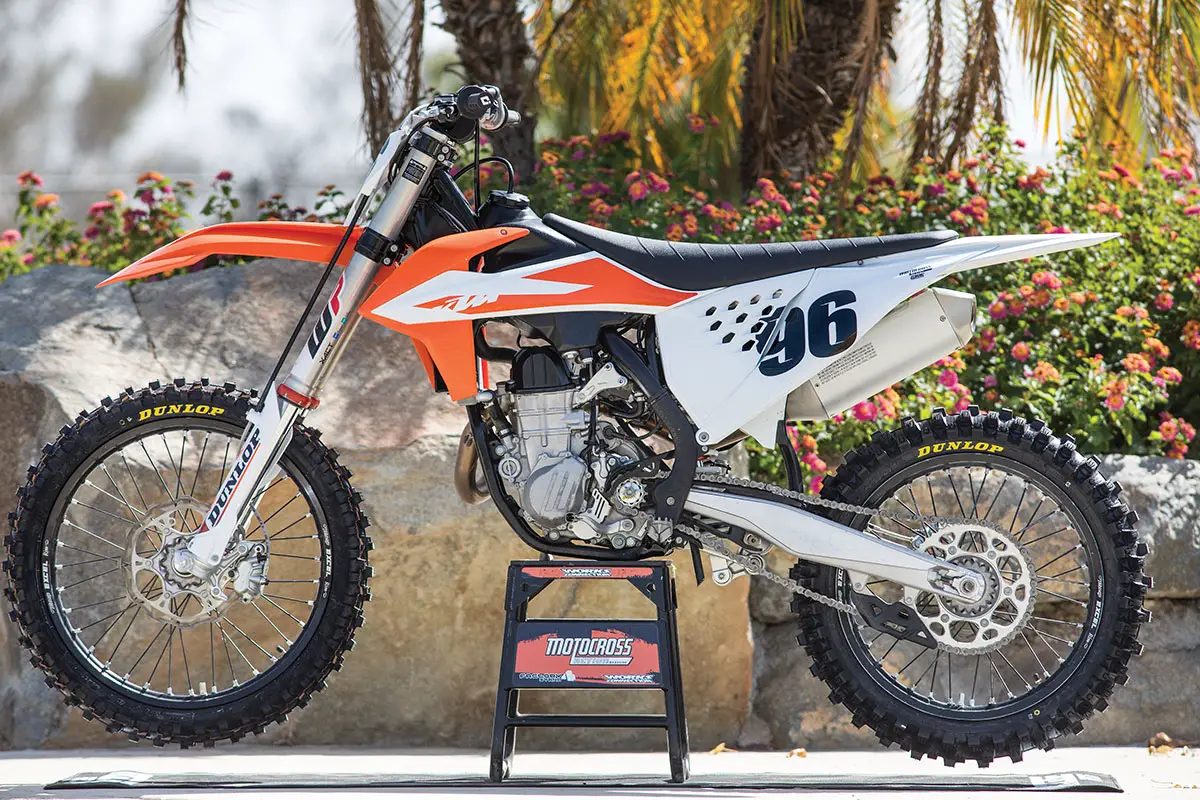
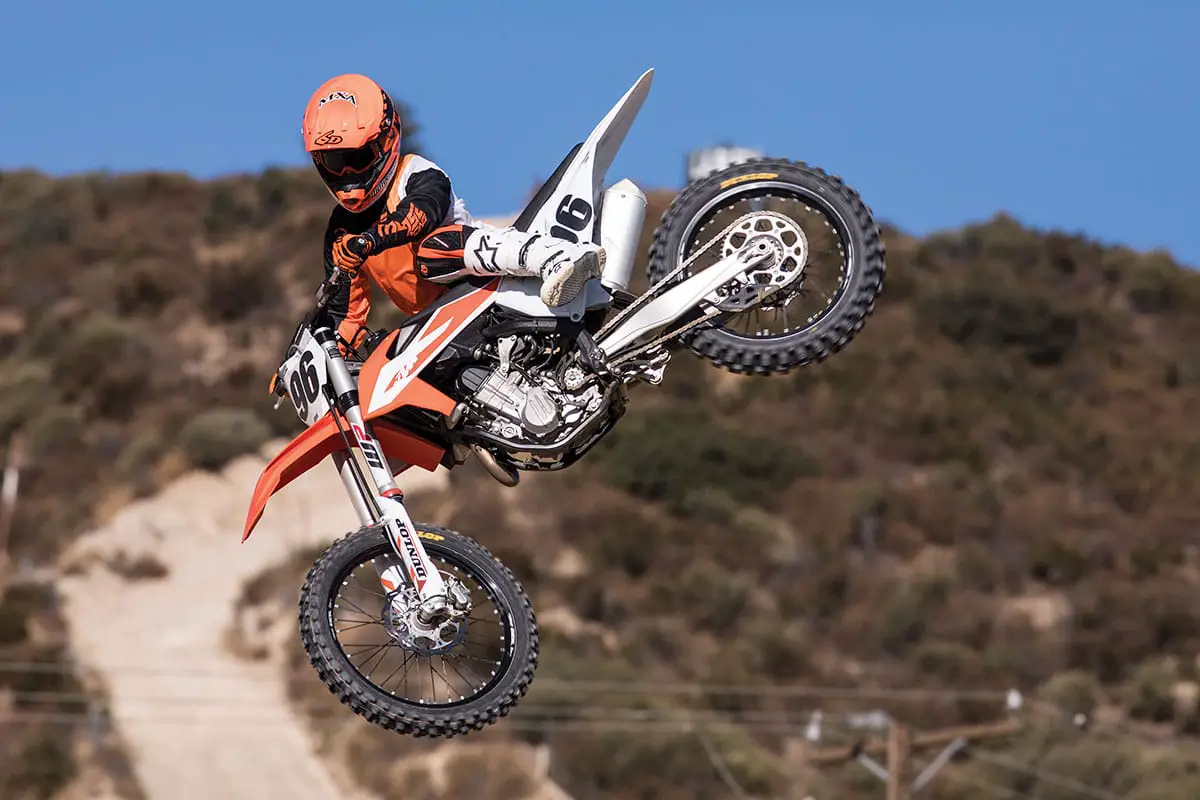

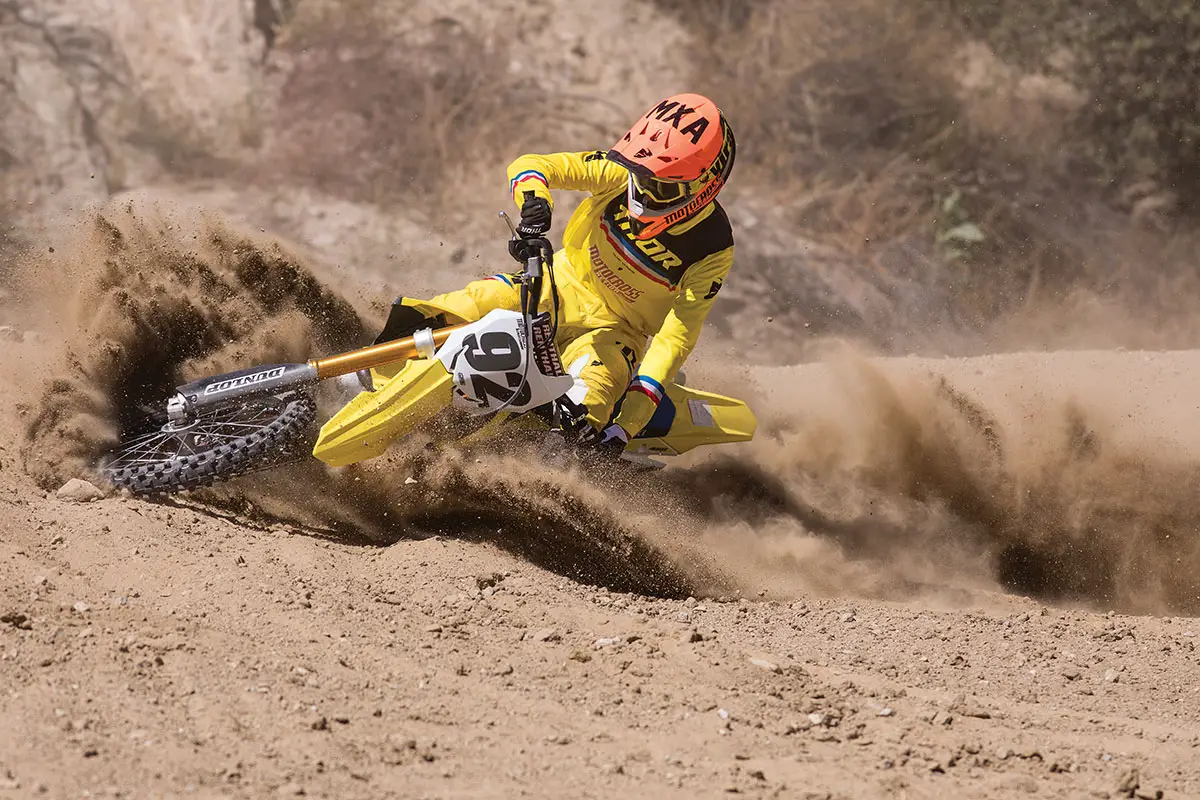

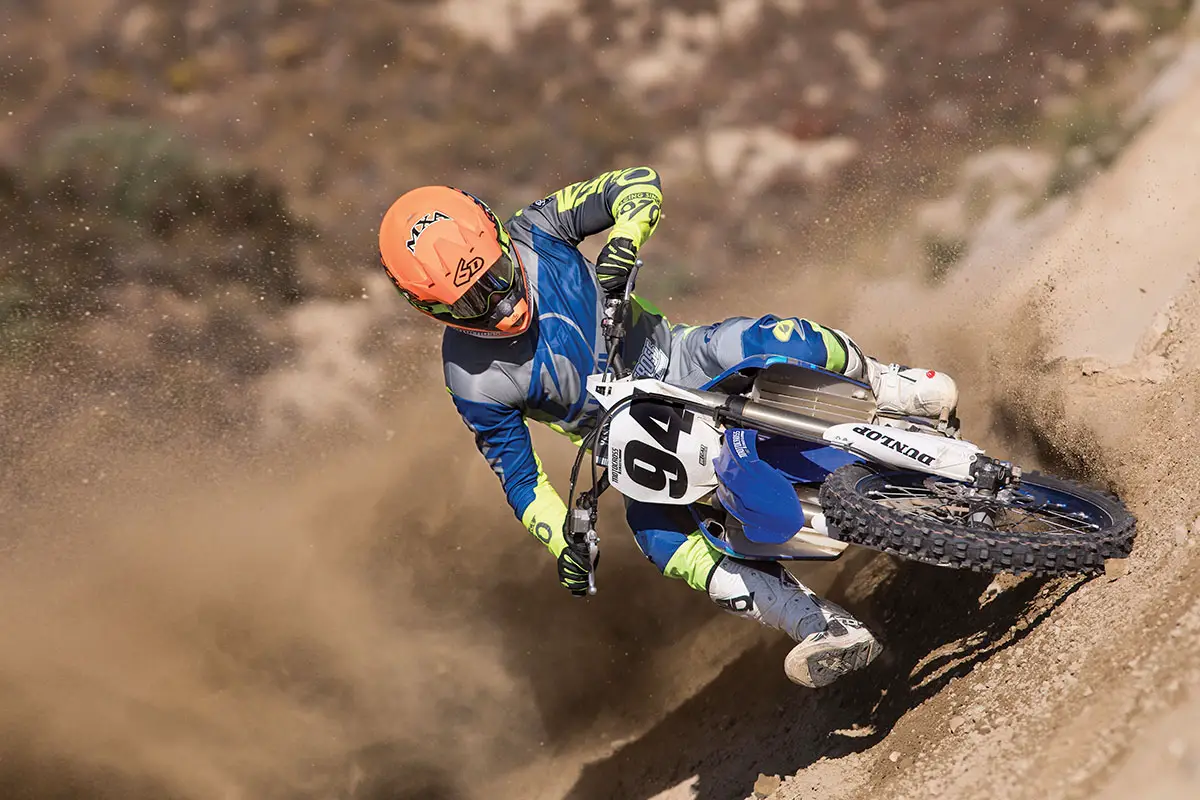

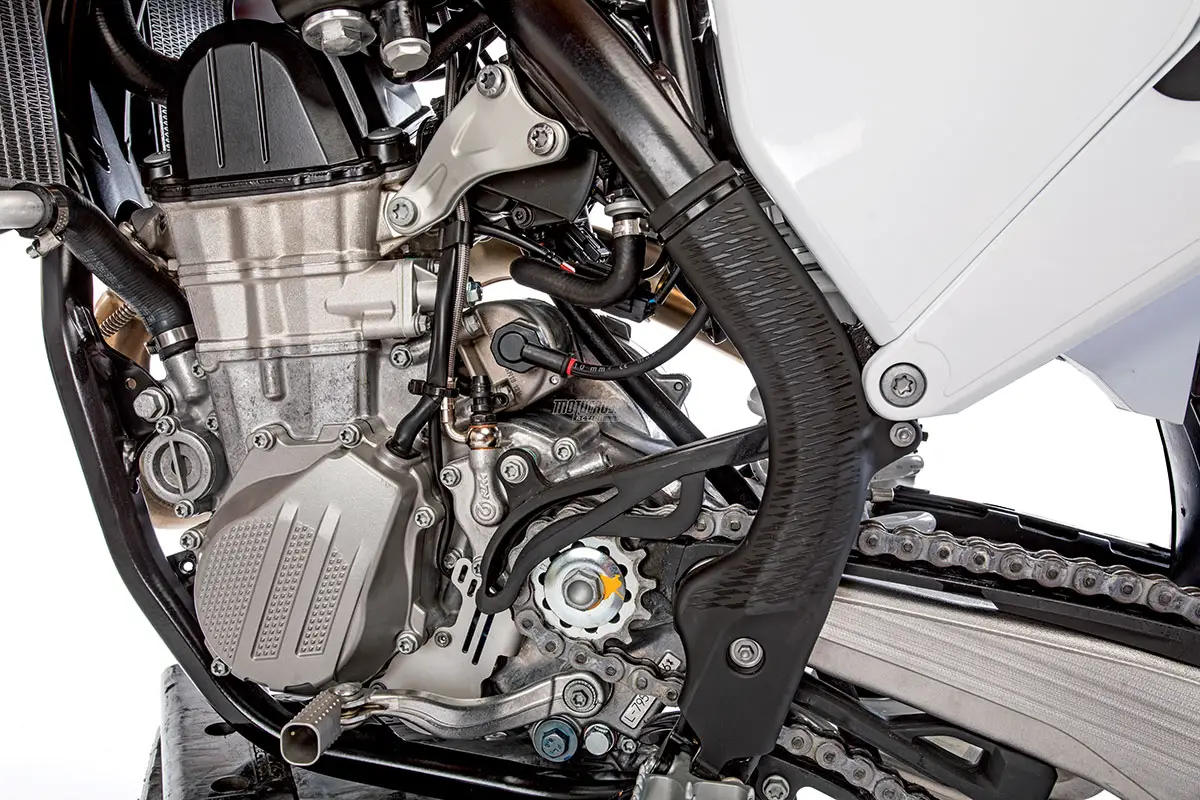
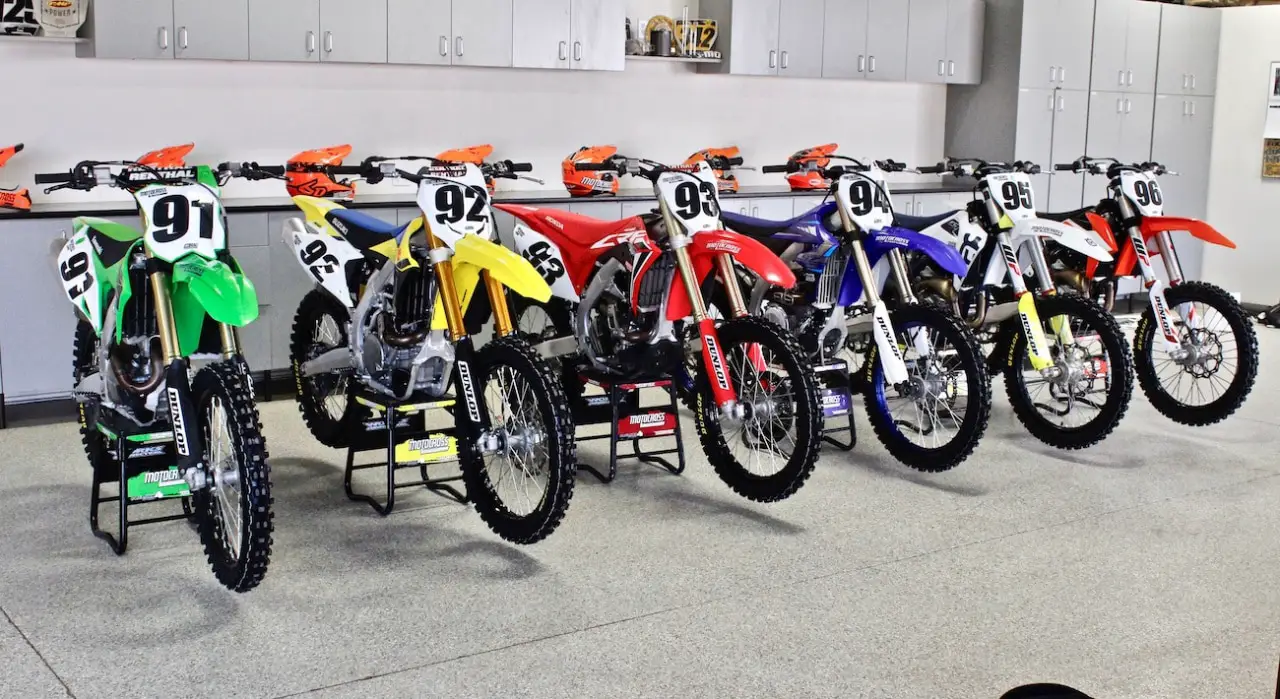
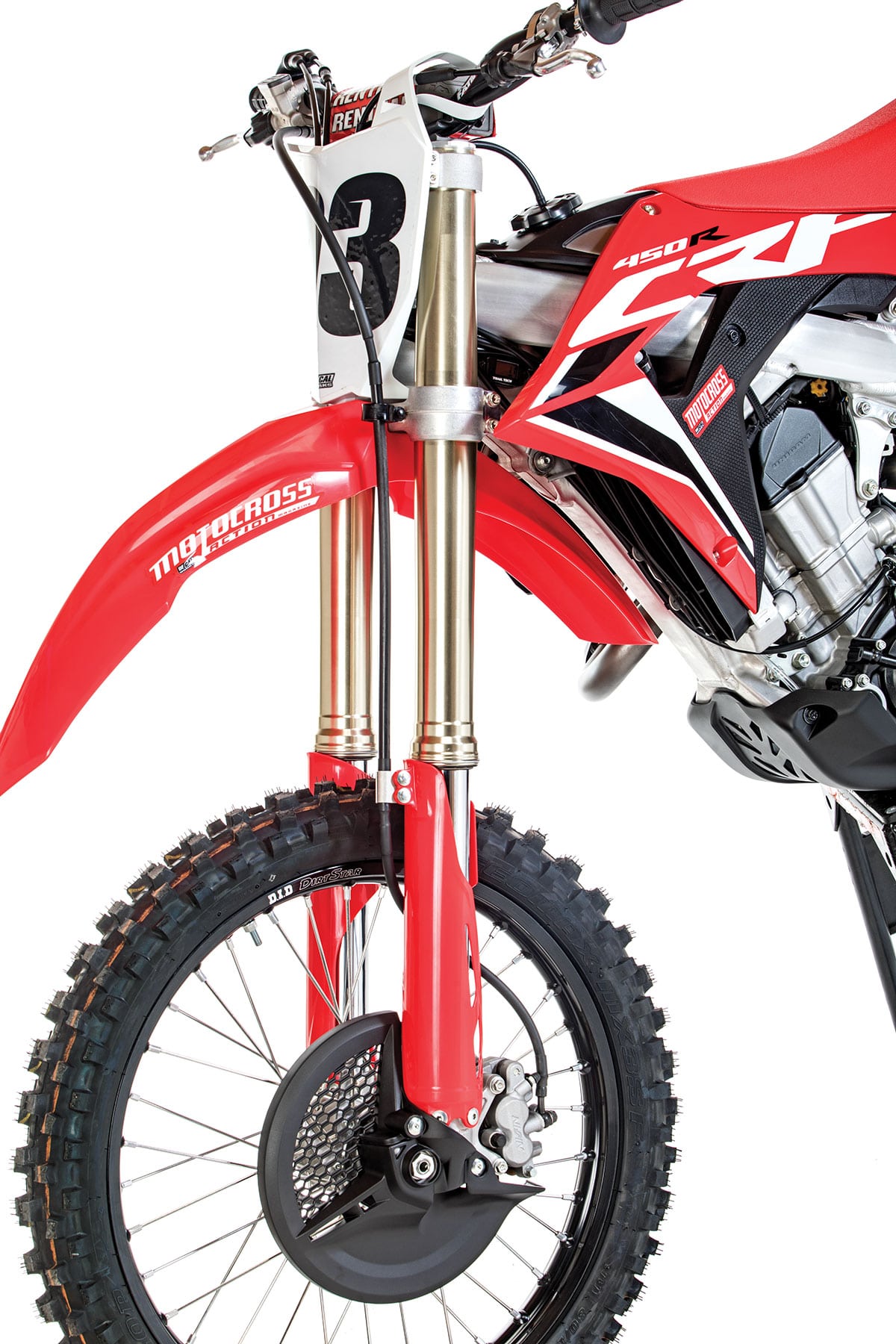


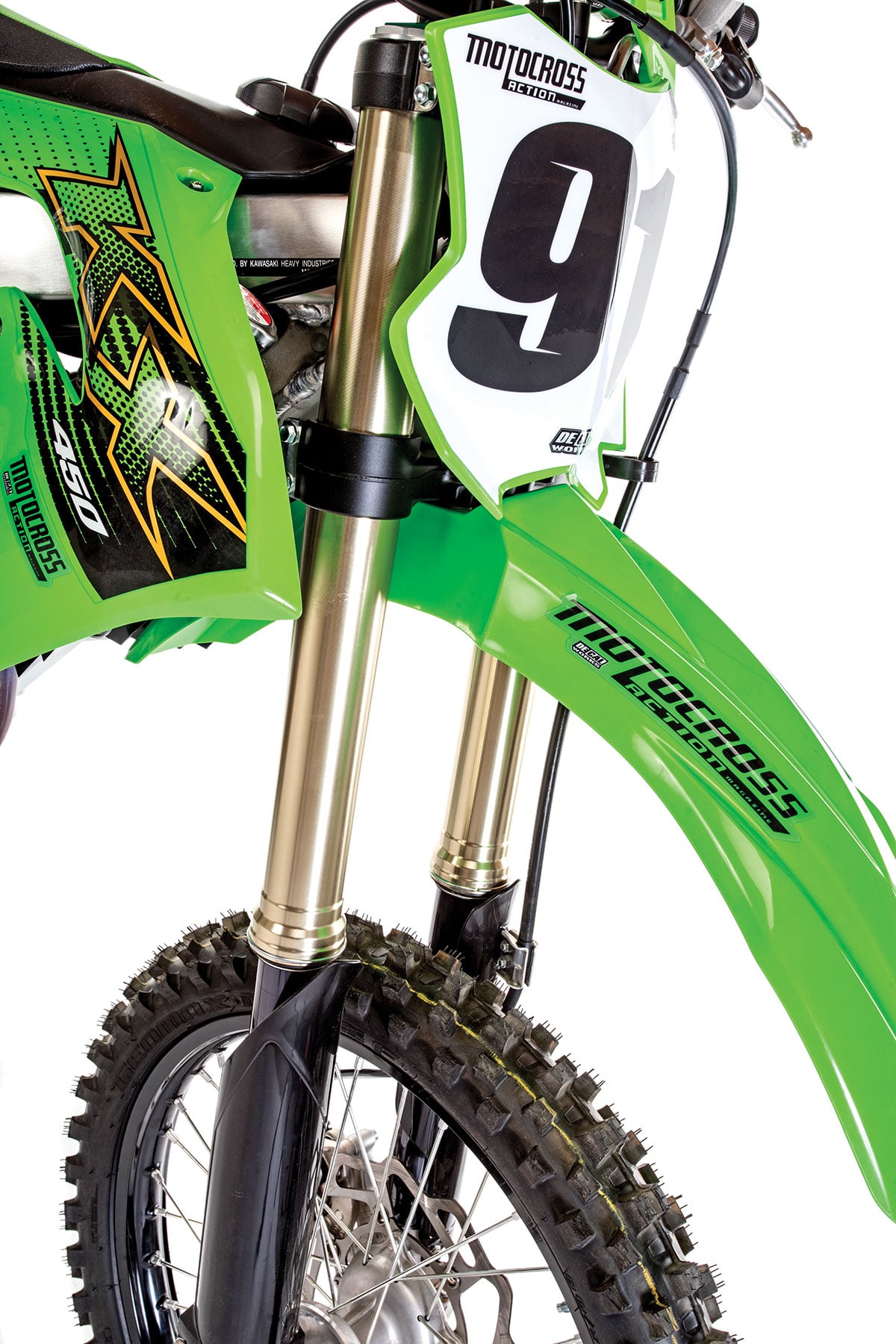


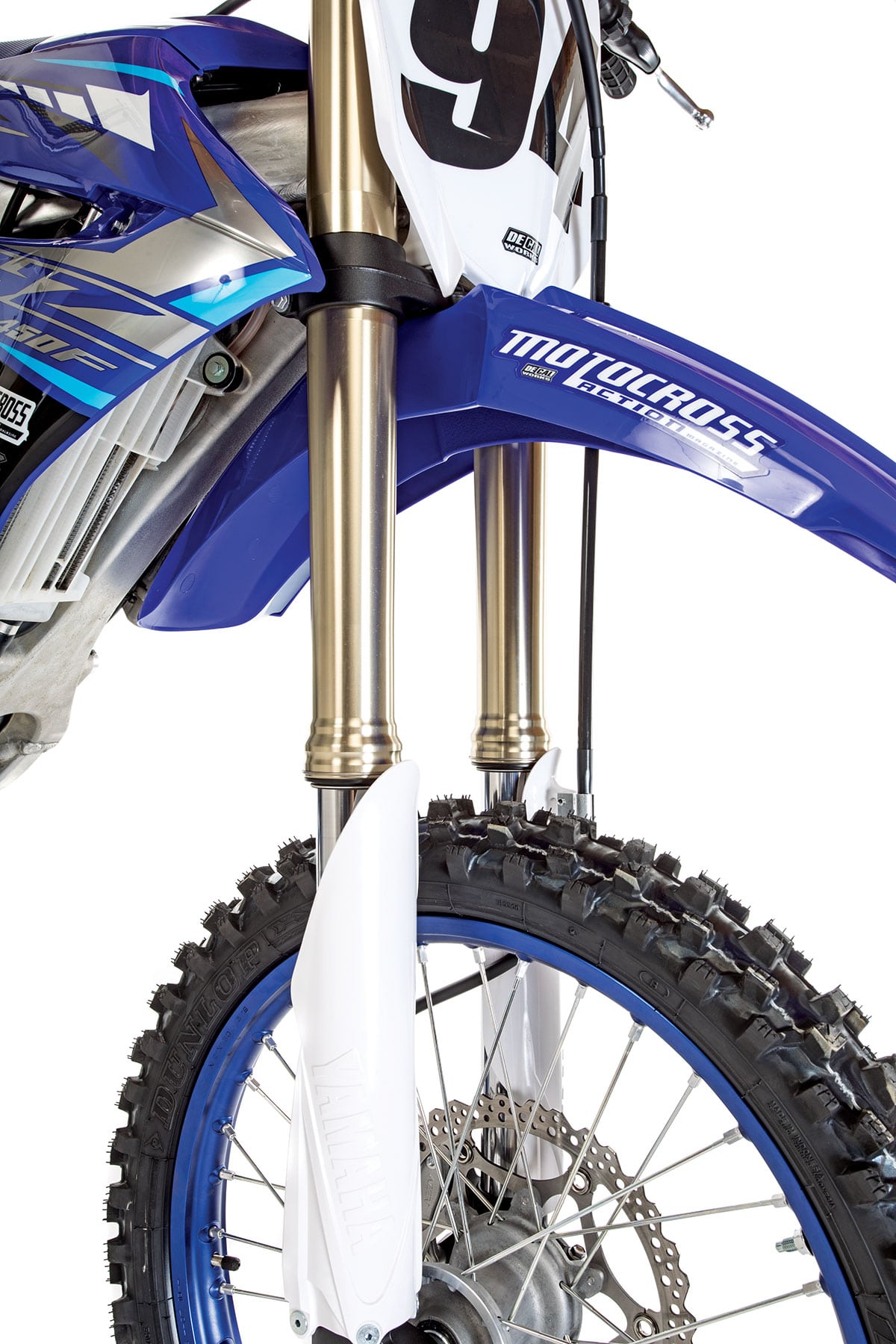
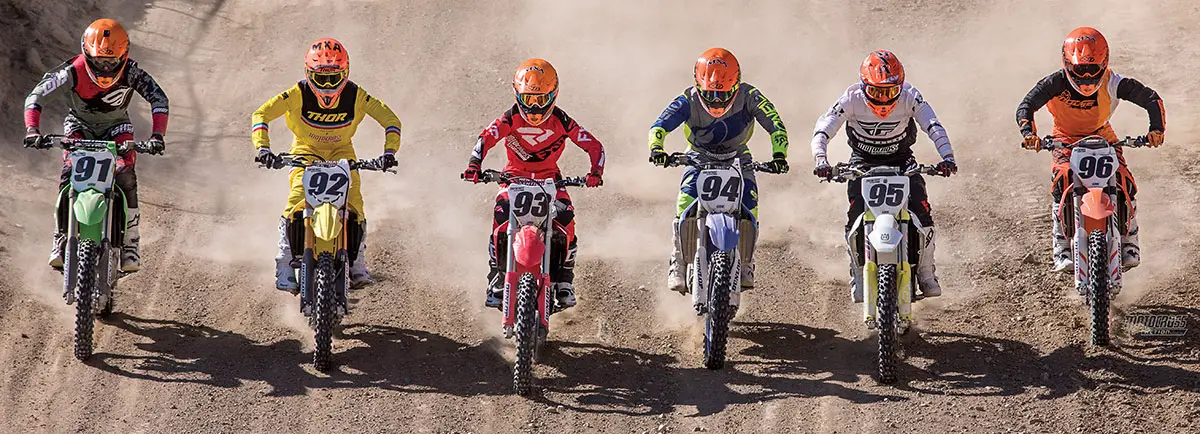

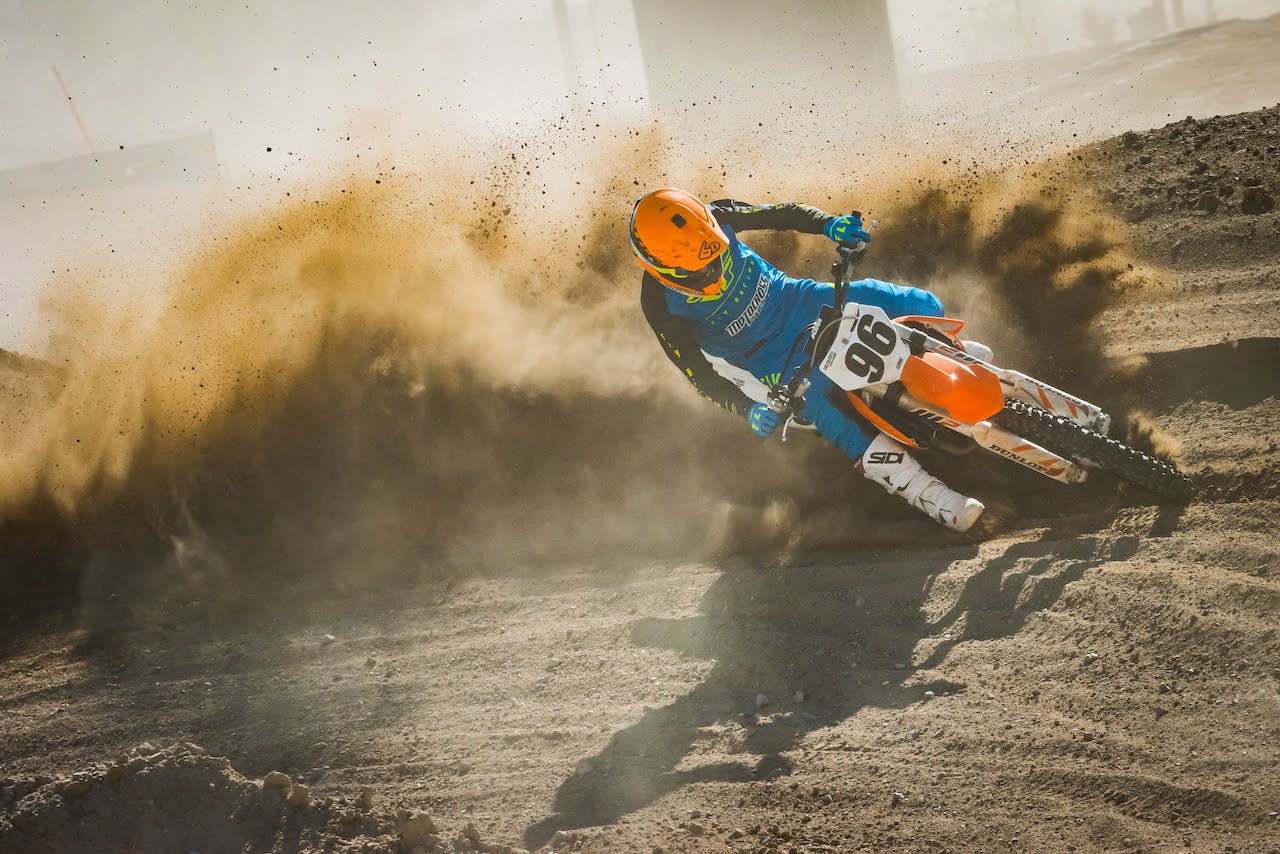



Comments are closed.